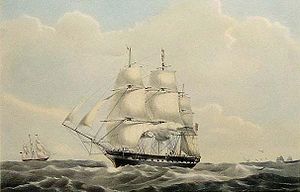Madagascar (ship)
 The Blackwall Frigate Madagascar - Lithograph c1853. | |
| Career (Great Britain) | |
|---|---|
| Builder: | Wigram and Green, Blackwall Yard, London |
| Launched: | 1837 |
| Homeport: | London |
| Fate: | Lost, 1853 |
| General characteristics | |
| Type: | Blackwall Frigate |
| Tonnage: | 951 "New Measurement" |
| Length: | 150 feet 7 inches (45.90 m) |
| Beam: | 32 feet 7 inches (9.93 m) |
| Draught: | 15 feet (4.6 m) fully laden |
| Depth of hold: | 22 feet 5 inches (6.83 m) |
| Propulsion: | Sail |
| Sail plan: | Three-masted full-rigged ship |
| Crew: | 60 |
The Madagascar was a large British merchant ship built for the trade to India and China in 1837, which went missing on a voyage from Melbourne to London in 1853. The disappearance of the Madagascar was one of the great maritime mysteries of the 19th century and was probably the subject of more speculation than any other 19th century disappearance except for the Mary Celeste.
Contents
The Madagascar - Building and Career
The Madagascar, the second Blackwall Frigate, was built for George and Henry Green at the Blackwall Yard, London shipyard they co-owned with the Wigram family.
A one-eighth share in the vessel was held throughout her 16-year career by her first master Captain William Harrison Walker, the remainder continuing to be owned by various members of the Green family. The Madagascar carried freight, passengers and troops between England and India until the end of 1852. In addition to her normal crew she also carried many boys being trained as officers for the merchant marine. Known as midshipmen from naval practise, their parents or guardians paid for their training, and they only received a nominal wage of usually a shilling a month.
The Madagascar's Final Voyage
As a result of the Victorian Gold Rush the Madagascar was sent to Melbourne with emigrants under the command of Captain Fortescue William Harris. She left Plymouth on 11 March 1853 and, after an uneventful passage of 87 days, reached Melbourne on 10 June. Fourteen of her 60 crew jumped ship for the diggings, and it is believed only about three replacements were signed on. She then loaded a cargo that included wool, rice and about two tonnes of gold valued at £240,000, and took on board about 110 passengers for London.
On Wednesday 10 August, just as she was preparing to sail, police went on board and arrested a bushranger John Francis who was later found to have been one of those responsible for robbing the Melbourne Private Escort between the McIvor goldfield (Heathcote, Victoria) and Kyneton on 20 July. On the following day two others were arrested, one on board the ship and the other as he was preparing to board. As a result of these arrests the Madagascar did not leave Melbourne until Friday 12 August 1853 and after leaving Port Phillip Heads she was never seen again.
When the ship became overdue many theories were floated, including spontaneous combustion of the wool cargo, hitting an iceberg and, most controversially, being seized by criminal elements of the passengers and/or crew and scuttled after the gold was stolen and the remaining passengers and crew were murdered. Even attack by pirates.
The Madagascar in Legend and Fiction
In 1872 rumours of a supposed death-bed confession by a man who "knew who murdered the captain of the Madagascar" were first published and over the next century many purely fictional stories based on this rumour have been published (being mentioned by authors of such reputation as Basil Lubbock and James A. Michener). Most 20th century versions state that the death-bed confession was by a woman passenger who was taken by the mutineers and by implication raped, and was too ashamed of what had happened to her to confess beforehand.
The legend of the Madagascar has also been used many times as a plot device in popular fiction, the earliest known usage being in Frank Fowler's Adrift; or The Rock in the South Atlantic in 1861 (which is probably the foundation of the modern mutiny legends), and later in Thomas Harrison's My Story; or, the Fate of the "Madagascar" first published as a serial in The Colonial Magazine, Melbourne in 1868. It probably influenced many other gold-rush era sea stories including Clark Russell's The Tale of Ten: A Salt Water Romance in 1896 and the alleged loss of the Starry Crown reported as fact in T. C. Bridges' The Romance of Buried Treasure in 1931 - which was in turn used in 1949 by Captain W. E. Johns in Biggles Breaks the Silence. The most recent usage in a fictional setting is probably Sandy Curtis' Deadly Tide in 2003 (ISBN 0-33036398-0 Publisher : Pan Macmillan Australia Pty Ltd.)
References
- Lubbock, Basil (1922), The Blackwall Frigates, Glasgow: Brown, Son & Ferguson
- Lewis, Jack (July 1983), "Bloody Mutiny of the 'Madagascar'", Sea Classics 16 (4)
- Stuart, Lurline (Autumn 2001), "The Lost Gold Ship", The La Trobe Journal (67)
- London Times Newspaper, various dates.
- Melbourne Argus newspaper, various dates.
